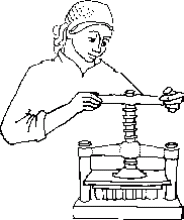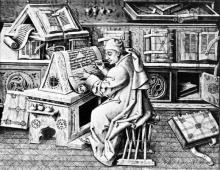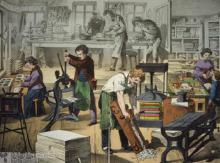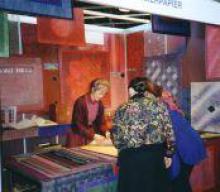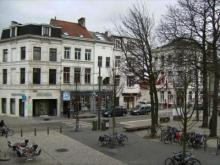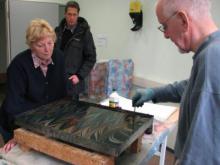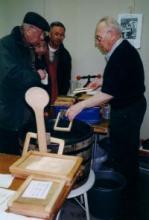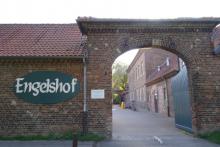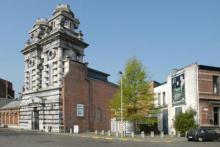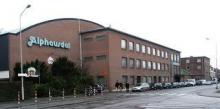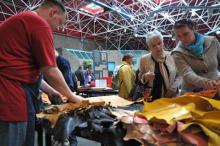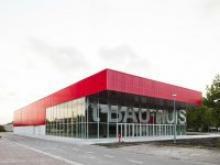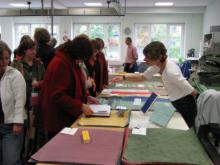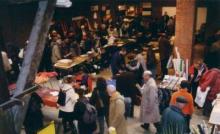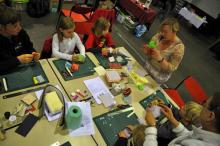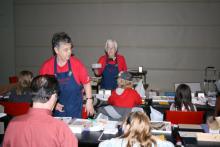History
HISTORY OF THE BOOKBINDERS’ FAIR
The development of bookbinding
Bookbinding is a very old craft, which was practiced in monasteries in the early Middle Ages. Among other things, we owe to this fact that written sources that are hundreds of years old are still available today. Since the invention of printing in the fifteenth century, there has been more and more work for bookbinders; a bindery was a thriving business. In libraries and museums, we can admire countless magnificent books that have been made over the centuries by bookbinding masters. Since industrialization in the 19th century, bookbinding has gradually been taken over by machines, and now hardly a human hand is used to finish the incredibly large annual book production. After the Second World War, manual bookbinding even threatened to disappear altogether; one had to search for hand bookbinderies with a magnifying glass. With the extinction of the craft, the knowledge and skills that had grown over the centuries were threatened to be lost.
Associations and magazines
The first fair in the Netherlands
Thanks to the passion and perseverance of few pioneers, this deplorable development was put to an end in the last quarter of the last century: a series of initiatives were founded to revitalize hand binding. In the Netherlands even two associations of hand binders and lovers of the hand-bound book were founded. Short courses in the craft were offered for interested people. An information leaflet was sent around within this small but growing circle. At one time, there were even two full magazines for hand bookbinders that have now been merged. In the mid-80s, the first Bookbinder’s Fair was organized in Amsterdam, which subsequently moved to Leiden. The manual binders scattered across the country had the opportunity to meet and buy the necessary materials at the same time.
Growth
Today one can see that the manual bookbinding is becoming increasingly popular. It is not just retirees who are involved in bookbinding; in recent years, the popularity with younger people is increasing. Bookbinding is once again part of the syllabus for training in the graphic professions. There are large international competitions for which good quality works are to be submitted. There is a general awareness for manual bookbinding today; it is practiced by many people with enthusiasm. And still it is true that they do it out of love for a beautiful craft and for the enjoyment of beautiful things; a well bound book is undoubtedly one of these.
To Belgium
Within about ten years, the bookbinder's fair in the Netherlands developed into a well-attended event eagerly awaited by bookbinders, book restorers, graphic designers and paper artists. The world-renowned marble maker Karli Frigge took the initiative and, together with several other exhibitors, ventured into Belgium. In the room behind a café on the Dageraadsplaats in Antwerp-Borgerhout they made a cautious attempt and organized the first bookbinding fair in Belgium. At the beginning there were few visitors. How should one reach the manual bookbinders and other potential interested parties in a foreign country without an association and without a journal?
Tenacity
And how does one find people all over Europe whose knowledge, expertise and work justify being shown at a bookbinder's fair? Stay tuned, keep searching, follow any suggestions, follow the developments and always be ready to win people over. The result was a success: after the first difficulties were overcome, the number of exhibitors increased steadily. The same was true for the Belgian bookbinders, who knew how to find the fair quickly and were enthusiastic.
Organization
In the meantime - it was the year 1998 - Karli had asked me for help in organizing and expanding the bookbinding fair in Belgium. Karli can make the most beautiful marbled papers, but organization is a very different thing. I had years of experience organizing large and small events and recently discovered the world of bookbinding. I gladly helped Karli. She passed her wide-ranging knowledge of bookbinding to me as well as her insights into the pros and cons of bookbinders and the practices of the marketplace. In early 2002, she retired from the organization.
Related trades
At the Bookbinder’s Fair one can learn in addition about the activities of other craftsmen and artists involved in the manufacture of hand binding materials and tools: papermakers, parchment makers, tanners, decorated paper makers, gilders and precision mechanics. Specialists demonstrated their skills in tool grinding, gilding, calligraphy, leather sharpening, marbling, papermaking, etc.
For all, it was and is true that they do their work in high quality and out of love for a craft that should not be forgotten.
Germany
In 2000, we decided to organize a trade fair in Germany, in Cologne. Even in Germany, a bookbinder's fair was previously unknown, so it was high time.
We found quarters in the “Werkstatt Palette”, a facility of GWK (Gemeinnützige Werkstätten Köln), in which people with disabilities work. The Werkstatt Palette has several work areas, among others printing (in the workshop are several beautiful printing presses) and bookbinding.
Thanks to the enthusiasm of the then manager Eberhard Maurer, who welcomed us hospitably and assisted us with words and deeds, the bookbinder's fair in Cologne could become a well-attended event. Each year, I was grateful to all the employees of the Palette for their great commitment to holding "their Bubi Fair".
In 2013 is was no longer possible to house the Bookbinders’ Fair in Die Palette, so we moved to the congenial venue of Engelshof on the periphery of the city of Cologne.
Venues
In 2003, the bookbinding fair in Belgium had already grown out of the second venue after seven years: the idyllic Zuiderpershuis on the Waalse Kaai in Antwerp. A beautiful house, but it was just too small. We found a new venue, Het Alpheusdal in Berchem; it was less atmospheric, but big enough and easy to reach. But unfortunately we could not stay there for long either. After four years, we suddenly received the news that the building was to be sold and demolished. The bookbinder's fair was homeless again. It was followed by a very tedious and long search, many possibly suitable rooms were visited, but everywhere was something wrong: too big, too small, too dark, difficult to reach by public transport, not to have on Sunday, too remote...
From Antwerp to Sint Niklaas
... until one day we received the advice to look at the Stadszalen in Sint Niklaas. And there it was, it was perfect for our purpose. So the bookbinder’s fair moved 2007 to Sint Niklaas.
Again, we were granted no long stay. the Stadszalen came to a premature end for us, after we had enjoyed our shelter there for five years. Fortunately, at the same time, the city of Sint Niklaas built a new hall just a stone's throw away so that from 2012 we could use the premises of the brand new “Bau-huis”. This is undoubtedly our "noblest" venue so far.
A showcase of the best
Over the years, with the help of many, it has been possible to bring an unusual group of mostly regular exhibitors from Belgium, the Netherlands, England, France, Austria, Spain and Denmark to the bookbinder's fair. They are all renowned experts in their fields, who together represent the best that can be found in the field of paper, leather, parchment and similar materials and tools; not only in Europe, but also in other parts of the world. The fair is now known for the incredibly wide range of special paper and leather types. That's why it is also interesting for non-bookbinders.
And now ...
At the bookbinder's fair, visitors are informed about courses, apprentice training, events, magazines and everything else worth knowing. One can buy literature, and there are demonstrations of papermaking, marbling, gilding and calligraphy. Workshops are organized: bookbinding for children, papermaking, making small books. Bookbinders from Germany and abroad as well as apprentices from different training courses regularly show their work. In addition, clubs and associations present themselves.
Ida Schrijver
Munnekeburen, 2013
Many thanks to John Gerard for his translation.
